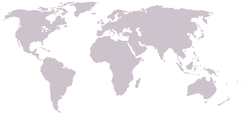Longman's Beaked Whale
|
|
| Longman's Beaked Whale Conservation status: Unknown | ||||||||||||||||
|---|---|---|---|---|---|---|---|---|---|---|---|---|---|---|---|---|
| Scientific classification | ||||||||||||||||
| ||||||||||||||||
| Binomial name | ||||||||||||||||
| Indopacetus pacificus | ||||||||||||||||
 Longman's Beaked Whale range |
Longman's Beaked Whale, commonly also called the Indo-Pacific Beaked Whale either has the specific name Indopacetus pacificus or Mesoplodon pacificus, depending whether the animal is classified as a mesoplodont whale or not. If the latter then it is one of fourteen species in the Mesoplodon genus. If the former, it is the sole member of the loosely-defined Indopacetus genus.
The species was initially identified from two skulls. However, in 2002, a 6.3 meters female carcase was found in the coast of Japan shortly after it beached [1] (http://news.bbc.co.uk/1/hi/sci/tech/2606829.stm). It is not known for certain that the species is not extinct. However there have been 45 reports of an unidentified cetacean locally known as the Tropical Bottlenose Whale in the temperate to tropic waters of the Indian and Pacific Oceans [4] (including some photographs - see [1]). The features of this unknown whale - in particular its length and well-defined crease between the melon and the beak - do not match those of any other member of the Ziphiid family in the area and do match what little has been inferred about Longman's Beaked Whale. Thus hope remains that the matter of the Indopacetus pacificus, probably the largest animal in the world never to have been identified alive, will be resolved.
In 2002 a previously unknown whale species stranded on the Japanese coast. It is believed to be the first complete specimen of Longman's Beaked Whale.
The species was originally described by Longman in 1926 from a skull found on a beach in Australia in 1882 and placed in the genus Mesoplodon. Over the next forty years researchers disputed that the skull belonged to a new species and variously suggested that it may belong to a sub-species of True's Beaked Whale or the Southern Bottlenose Whale. However in Joesph Moore rejected these disputes. In 1968 he analysed a second skull found on the floor of a factory in Mogadishu, Somalia in 1955. The skull had been recovered from nearby beach by fishermen. From the two skulls Moore suggest that in fact the species belonged to a separate genus. In his papers [5],[6] Moore gives five reasons for this relating to the shape and size of the skull. The conclusions have never been completely accepted by all workers.
No definite findings are available on the shape and colouring of the whale.
References
- Indo-Pacific Beaked Whale in the Encyclopedia of Marine Mammals Robert L. Pitman, 1998. ISBN 0125513402
- National Audubon Society Guide to Marine Mammals of the World Reeves et al, 2002. ISBN 0375411410.
- Whales, Dolphins and Porpoises Carwardine, 1995. ISBN 0751327816
- Sightings and possible identification of a bottlenose whale in the tropical Indo-Pacific: Indopacetus pacificus? Pitman, Palacios, Brennan, Brennan, Balcomb and Miyashita, 1999. Marine Mammology Science Vol 15, pps 531-549.
- Relationships among the living genera of beaked whales with classifications, diagnoses and keys J.C. Moore 1968. Field Zoology. Vol 53, pps 206-298.
- More skull characters of the beaked whale Indopacetus pacificus and comparative measurements of austral relatives J.C. Moore 1972. Field Zoology. Vol 62 pps 1-19.
- Rare whale washes up in South Africa (http://news.bbc.co.uk/1/hi/world/africa/2172543.stm)
- On an unidentified beaked whale found stranded in Kagoshima (http://svrsh1.kahaku.go.jp/sendai/indexE.html)da:Longmanns næbhval
